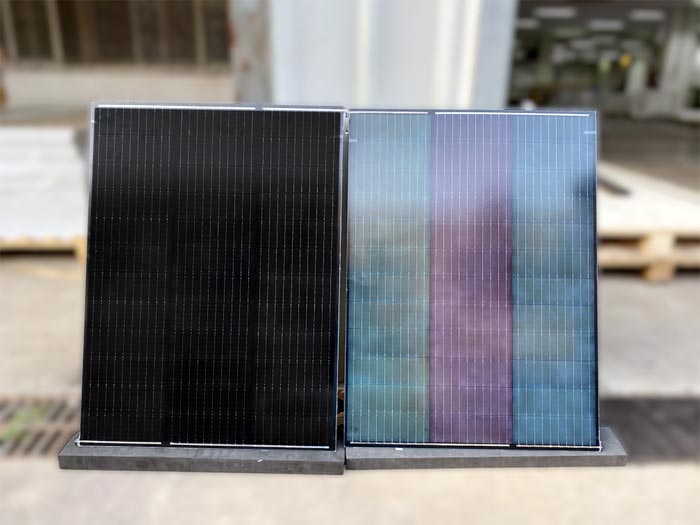Colorful solar panels could make the technology more attractive

Photonic glasses give solar panels pleasing colors while maintaining their ability to efficiently produce energy.
Credit: Adapted from ACS Nano 2022, DOI: 10.1021/acsnano.2c05840
Solar panels aren’t just for rooftops anymore – some buildings even have these power-generating structures all over their facades. But as more buildings and public spaces incorporate photovoltaic technologies, their monotonous black color could leave onlookers underwhelmed. Now, researchers reporting in ACS Nano have created solar panels that take on colorful hues while producing energy nearly as efficiently as traditional ones.
Solar panels are typically a deep black color because their job is to absorb light, whereas a red car looks red because the finish reflects red light instead of absorbing it. Most attempts to give these devices color, then, will decrease their ability to absorb light and generate power. One alternative is to use structural sources of color that take advantage of microscopic shapes to only reflect a very narrow, selective portion of light, like the scales on butterfly wings. However, previous technologies attempting to incorporate structural color gave panels an undesirable iridescence or were expensive to implement at a large scale. So, Tao Ma, Ruzhu Wang, and colleagues wanted to develop a way of giving solar panels color using a structural material that would be easy and inexpensive to apply, and that would maintain their ability to produce energy efficiently.
The team sprayed a thin layer of a material called a photonic glass onto the surfaces of solar cells. The glass was made of a thin, disorderly layer of dielectric microscopic zinc sulfide spheres. Although most light could pass through the photonic glass, selective colors were reflected back based on the sizes of the spheres. Using this approach, the researchers created solar panels that took on blue, green and purple hues while only dropping the efficiency of power generation from 22.6% to 21.5%. They also found that solar panels manufactured with this photonic glass layer maintained their color and performance during standard durability tests, and that the fabrication could be scaled up. The researchers plan to explore ways to make the colors more saturated, as well as methods to achieve a wider range of colors.
The authors acknowledge funding from the National Natural Science Foundation of China.
For more of the latest research news, register for our upcoming meeting, ACS Fall 2022. Journalists and public information officers are encouraged to apply for complimentary press registration by completing this form.
The American Chemical Society (ACS) is a nonprofit organization chartered by the U.S. Congress. ACS’ mission is to advance the broader chemistry enterprise and its practitioners for the benefit of Earth and all its people. The Society is a global leader in promoting excellence in science education and providing access to chemistry-related information and research through its multiple research solutions, peer-reviewed journals, scientific conferences, eBooks and weekly news periodical Chemical & Engineering News. ACS journals are among the most cited, most trusted and most read within the scientific literature; however, ACS itself does not conduct chemical research. As a leader in scientific information solutions, its CAS division partners with global innovators to accelerate breakthroughs by curating, connecting and analyzing the world’s scientific knowledge. ACS’ main offices are in Washington, D.C., and Columbus, Ohio.
To automatically receive news releases from the American Chemical Society, contact newsroom@acs.org.
Journal: ACS Nano
DOI: 10.1021/acsnano.2c05840
Article Title: High-Efficiency, Mass-Producible, and Colored Solar Photovoltaics Enabled by Self-Assembled Photonic Glass
Article Publication Date: 18-Jul-2022
Media Contacts
ACS Newsroom
American Chemical Society
newsroom@acs.org
Katie Cottingham
American Chemical Society
k_cottingham@acs.org
Office: 301-775-8455
All latest news from the category: Life Sciences and Chemistry
Articles and reports from the Life Sciences and chemistry area deal with applied and basic research into modern biology, chemistry and human medicine.
Valuable information can be found on a range of life sciences fields including bacteriology, biochemistry, bionics, bioinformatics, biophysics, biotechnology, genetics, geobotany, human biology, marine biology, microbiology, molecular biology, cellular biology, zoology, bioinorganic chemistry, microchemistry and environmental chemistry.
Newest articles

First-of-its-kind study uses remote sensing to monitor plastic debris in rivers and lakes
Remote sensing creates a cost-effective solution to monitoring plastic pollution. A first-of-its-kind study from researchers at the University of Minnesota Twin Cities shows how remote sensing can help monitor and…

Laser-based artificial neuron mimics nerve cell functions at lightning speed
With a processing speed a billion times faster than nature, chip-based laser neuron could help advance AI tasks such as pattern recognition and sequence prediction. Researchers have developed a laser-based…

Optimising the processing of plastic waste
Just one look in the yellow bin reveals a colourful jumble of different types of plastic. However, the purer and more uniform plastic waste is, the easier it is to…



